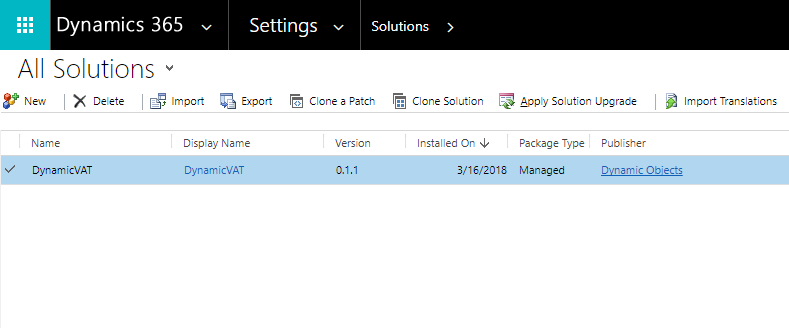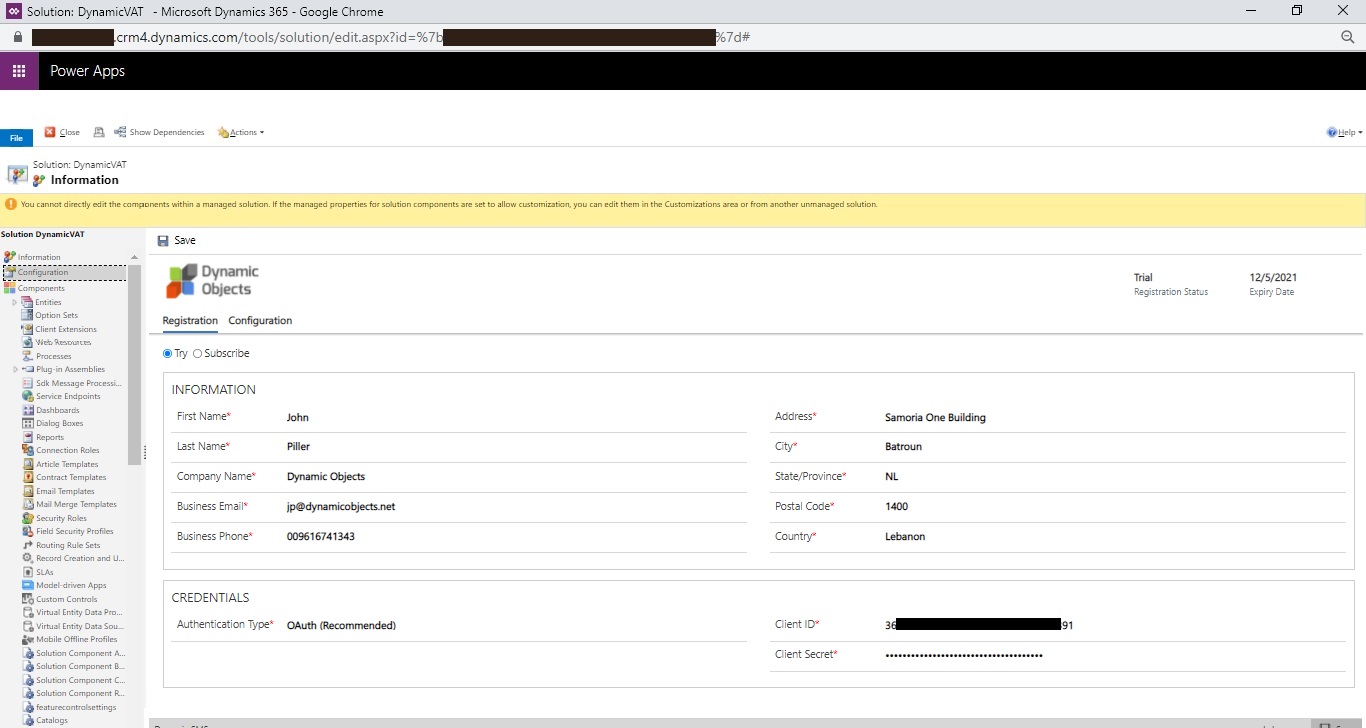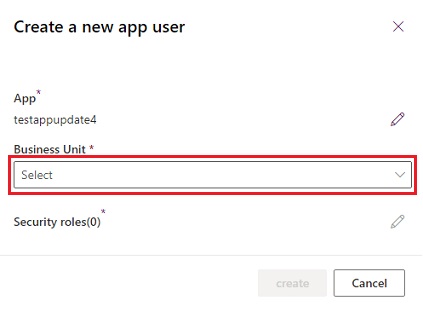Solution Import
Please follow the below steps in order to start the import process:
1. Go to the Download button on the solution page and download the latest solution zip file.

2. Login to your Microsoft Dynamics CRM/365 organization and head to Settings -> Solutions and click on the Import button.

3. Select the solution file that you downloaded in Step 1 and Press Next.

4. Verify that you imported the correct Solution by checking the solution information and package details and press Next.

5. Please make sure that the "Enable any SDK message processing steps included in the solution" option is selected and select Import.

6. The Solution import process will start. Please wait around 5 minutes for the solution import process to complete.

7. Once the import is complete, you will see a screen with an overview of the import and components. Please click Close and proceed to Solution Registration.
Registration
When the import process is complete, please double click on the solution imported to start the registration process.

2. Please fill-in your details in the Information section and make sure to enter the correct email details in order to receive important updates about the solution.

In the Credentials section, you will need to select the Authentication type, in both options the user needs to be allocated the "DynamicVAT - Service User" role which will be used to renew your subscription.

For the Microsoft 365 (Deprecated), please type in the appropriate Username and Password. The credentials are the login credentials to D365.

For the OAuth (Recommended), please type in the Client ID and Client Secret, how to get them is elaborated in Registering

Once all the information is entered, please click Submit and you are subscribed for the 30-day trial.


Register App and Create App User
To be able to use the OAuth authentication type, you need to register a new Dynamics 365 App, give it specific right to access D365 and create an App User with security role to access D365 and the solution you registered.
Before starting, please make sure you have access to Azure Active Directory Portal and Power Platform Admin Center with an Administrator user.
Note: Please note that Registering an App will not make the solution work, you will need to create an App User and give him access to D365 and the solution you registered.
Register APP
1. First you need to connect to Azure Portal (https://aad.portal.azure.com/) with administrator credentials.
2. From the homepage, click on Azure Active Directory -> App Registration -> New Registration

3. In the Application registration form, you have to enter some information:
- Name: this is the name of the registration app. Enter a meaningful one.
- In the Supported account types part, select Accounts in any organizational directory
- Set the redirectUrl. In our case, let's use Web and http://localhost
Then click on Register

4. Your application is registered. From the overview, you can find
- The Application Id
- The Tenant Id
Copy them somewhere you will need it later.

5. Now go on API permissions

6. Click on Add a permission

7. Select Dynamics CRM under the API Microsoft Graph tab.

8. Click on Delegated permissions, check the options and click on Add permissions.
9. Now Click on Certificates & Secrets and create a new client secret.

10. Add a name and define the expiration duration of your secret value.
Then click on Add.

11. Your client secret is now created. Copy and keep its value somewhere safe because you won’t be able to copy again once the page is reloaded.

Create APP User
First you need to connect to
You can create an unlicensed application user in your environment. This application user will be given access to your environment's data on behalf of the user who's using your application.
In an environment, you can only have one application user for each Azure AD-registered application.
1. Sign in to the Power Platform admin center (https://admin.powerplatform.microsoft.com/ ) as a System Administrator.
2. Select Environments, and then select an environment from the list.
3. Select Settings.
4. Select Users + permissions, and then select Application users.
5. Select + New app user to open the Create a new app user page.

6. Select + Add an app to choose the registered Azure AD application that was created for the selected user, and then select Add.
Note: You can also choose an Azure Managed Identity via this experience.

7. The selected Azure AD app is displayed under App. You can select Edit to choose another Azure AD application. Under Business Unit, select a business unit from the dropdown list.

8. After choosing a business unit, you can select edit button for Security roles to choose security roles for the chosen business unit to add to the new application user. Make sure you give this user "Dynamic SMS - Service User".
After adding security roles, select Save.

9. Select Create.
Configuration
Now that you successfully registered your solution, you need to click on the Configuration tab to configure VAT Rate and how it will be applied.

Please add a value to Default VAT Rate (%) to be applied at the level of Opportunity Product, Quote Product, Order Product and Invoice Product if neither the Product itself nor one of its parent Products has been defined with a VAT Rate.
Choose if you want to add the Default Rate set to write in products when added by setting Enable for Write-In Products to Yes.
Choose if you want to take the Parent Product set rate whenever a product has none by setting Enable Inheritance to Yes.
Click Save once you are done.
Note: All configurations set will take effect on new Opportunity Products, Quote Products, Order Products and Invoice Products created only.

Subscription
The trial solution will expire after 30 days; thus, you need to subscribe in order to continue using the solution features. The steps are as follows:
1. Under Register section click Subscribe.
2. In the Payment Plan Section, select either Monthly Plan or Yearly Plan for your Subscription to be renewed and your card to be billed every month or every year.
3. In the Billing Address Section, Enter the billing address. You can use the Copy Address Above button to automatically copy the address details entered above or enter a different billing address.

4. Once the Plan is selected and the billing fields are filled, press the Submit Button and you will be presented with the End User License agreement. Please read it carefully and press Accept to continue to the payment page.

5. The payment page lists the amount that you will be billed depending on your selected plan (Monthly or Yearly).
Enter your Card Number, Expiration Date, CVV and Cardholder Name and press the Pay Button.
Note that we currently support only visa and Mastercard as payment methods.

If the payment is Successful, you will be routed to the Configuration Page and the solution is extended for another period as per your selection (Month or Year).
The Payment Method section lists the masked card details, so you keep track of the payment details used.
Please note that The solution will automatically renew every month/year on the expiration date.
If you wish to stop using the solution, please click on the Unsubscribe button and confirm.
The solution will remain active until the expiry date.
